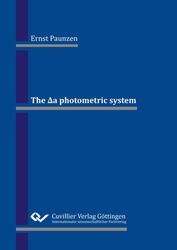| Departments | |
|---|---|
| Book Series (96) |
1378
|
| Nachhaltigkeit |
3
|
| Gesundheitswesen |
1
|
| Humanities |
2363
|
| Natural Sciences |
5406
|
| Mathematics | 229 |
| Informatics | 319 |
| Physics | 980 |
| Chemistry | 1363 |
| Geosciences | 131 |
| Human medicine | 243 |
| Stomatology | 10 |
| Veterinary medicine | 108 |
| Pharmacy | 147 |
| Biology | 835 |
| Biochemistry, molecular biology, gene technology | 121 |
| Biophysics | 25 |
| Domestic and nutritional science | 45 |
| Agricultural science | 1004 |
| Forest science | 201 |
| Horticultural science | 20 |
| Environmental research, ecology and landscape conservation | 148 |
| Engineering |
1791
|
| Common |
98
|
|
Leitlinien Unfallchirurgie
5. Auflage bestellen |
|
Advanced Search
The ∆a photometric system (English shop)
Ernst Paunzen (Author)Preview
Extract, PDF (320 KB)
Table of Contents, PDF (54 KB)
This book describes the characteristics and applications of the Δa photometric system, which measures the stellar flux at around 520 nm.
Since its introduction in 1976 by Hans-Michael Maitzen, the Δa system has not only been successfully applied to the classical chemically peculiar stars of the upper main sequence, but also to galactic and extragalactic star clusters. New possible applications for studying galaxies, quasars and other astrophysical objects of interest are discussed.
| ISBN-13 (Hard Copy) | 9783736972834 |
| ISBN-13 (eBook) | 9783736962835 |
| Final Book Format | A5 |
| Language | English |
| Page Number | 248 |
| Lamination of Cover | matt |
| Edition | 1 |
| Publication Place | Göttingen |
| Publication Date | 2020-10-13 |
| General Categorization | Non-Fiction |
| Departments |
Physics
Astrophysics and astronomy |
| Keywords | Sterngruppen, Sternhaufen, star clusters, Δa-Photometersystem, Galaxie, Quasars, Quasaren, CP1-Sterne, CP2-Sterne, CP3-Sterne, CP4-Sterne, stars, λ Bootis Sterne, Programmsterne, program stars, Rötung, reddening, Isochrone, Isochronenanpassung, isochrone fitting, Δa-Filtersystem,Δa filter system, Luminositätseffekte, luminosity effects, Metallizitätseffekte, metallicity effects, Modellatmosphäre,model atmosphere, Spektroskopie, Abundanz, Mikroturbulenz, microturbulence, Magnetfelder, magnetic fields, Abundanzmuster, abundance patterns, spektroskopische Doppelsterne, spectroscopic binary stars, Doppelsternsystem, binary star system, Kugelsternhaufen, globular clusters, Magellansche Wolke, Magellanic Cloud, Licht-Variabilität, light variability, Lichtschwankungen, light variations, Emissionslinien, emission lines, absorption, CCD-Technologie, Photomultiplier, Belichtungszeit, exposure time, Zielhelligkeit, target brightness, Astrophysik, astrophysics, Sternwarte, observatory, Hans-Michael Maitzen, V-Lichtkurve, Wellenlänge, wavelengths, Asteroseismologie, asteroseismology. Standardabweichung, standard deviation, Photonenrauschen, Nachweisgrenze, photon noise, detection limit, Helligkeitsklasse, luminosity classes, Helium, Blaue Nachzügler, Blue Stragglers, Sternkollision, star collision |








